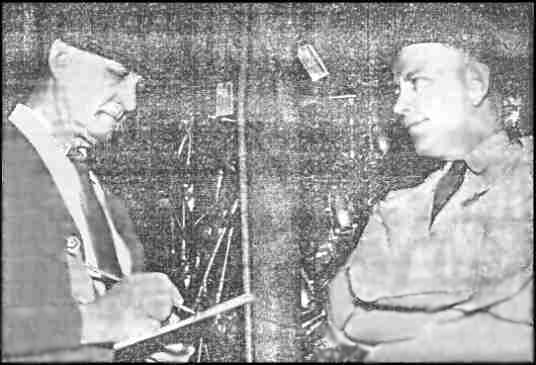
 |
|
RETIRES --- Joseph L. Cato, 409 Thor street, left, talks with Lt. Col. Martin E. Riley, commanding officer of the 93rd Maintenance
squadron at Castle Air Force Base, on Cato's last day of work before retiring after 12 years at Castle and 44 years as an experimental
aeronautical engineer. The veteran Turlock engineer's quick eye for improvements in design, construction and operation have saved
this government and the aviation industry many thousands of dollars. |
|
Retires After 44 Year Career by DAVE CUMMEROW Joseph L. Cato, 409 Thor Street, can sit back now and tell you how time flies. In fact, there are few persons better qualified than he to tell you how anything flies. Cato, an experimental aeronautical engineer, retired at the end of last month after devoting 44 years to the progress of aviation. The last 12 of those years have been spent at Castle Air Force Base. During his dozen years of service at the nearby air field, the veteran eingineer has many times been commended by high-ranking Air Force officials for his contributions to aviation mechanics. Under the employee suggestion program, he has received nearly 50 awards for ideas that have improved operating and maintenance tecnhiques --- ideas which have been put into industry-wide use and have saved this nation many thousands of dollars. Parting Award The award for his most recent suggestion and a letter of commendation were presented to him upon the recommendation of Col Gilbert F. Frederichs, base commander. Cato's record in Who's Who In Aeronautics takes up more space than that allotted to many men more widely known in American aviation. It starts in 1908 when the serious-minded engineer was but 19 years old. In that year, he submitted a design to the War Department for a power driven airplane for military use. The following year, he started work on a Curtiss type single surface plane in Alameda and made his first solo hop in it later that year. In 1910, he designed and built a new type monoplane and was credited that year as the creator of one of the first air cooled engines. By the end of the next year, he had completed his third machine and designed a nine-cylinder air-cooled rotary engine incorporating what were then sensational new principles, but which have since been almost universally adopted. All in all, he designed and built 14 different types of planes and had a part in the re-designing of nine other models. The first Liberty engine to fly was one of his installation jobs along with 28 other different models which he installed and operated. He has made application for 14 patents and holds rights on at least 10 of those. Flew Them, Too As an enthusiastic young engineer, Cato was more than just a ground man. When he built them, he wanted to fly them. And he has put in considerable time aloft doing exhibition flying. During the course of his career, Cato, now 64 years old, has taken an active part in raising the aircraft industry from a gangling, unsure infant to the mature, graceful giant of the skies. He has known and worked with the pioneers of aviation --- from the Wright Brothers right on through to the great wartime producers of today. Cato's contributions to the air force have not been limited to the field of mechanics. He and Mrs. Cato also have helped to staff that branch of the service. Their daughter, Phyllis, is a lieutenant in the Women's Air Force, now stationed at Spokane, Wash. Like all aviation enthusiasts, Cato believes the future of this mushrooming industry has only begun to unfold, and he is retiring with the confident hope that his ideas will contribute to the safety and efficiency of future airborne traffic. many already have. Courtesy of Phyllis Cato Ferguson |


|